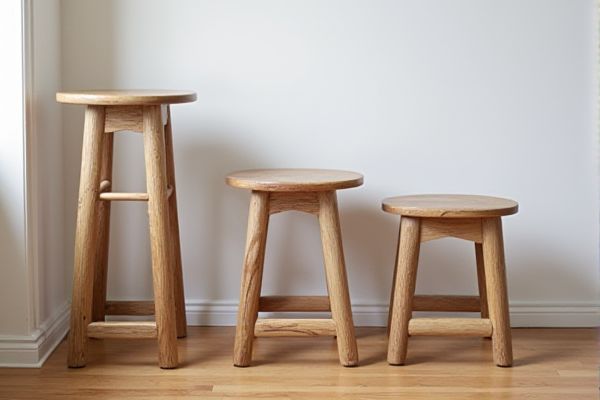
Stackable stools save space by neatly nesting vertically, making them ideal for compact areas and easy storage, while folding stools collapse flat for portability and quick setup, perfect for on-the-go use and occasional seating. Explore the rest of the article to discover which stool best suits your lifestyle and space requirements.
Table of Comparison
| Feature | Stackable Stools | Folding Stools |
|---|---|---|
| Design | Rigid, stackable frame | Collapsible, foldable frame |
| Storage | Stacks vertically, saves floor space | Folds flat, easier compact storage |
| Portability | Less portable, heavier | Highly portable, lightweight |
| Setup | Ready to use immediately | Requires unfolding before use |
| Durability | Usually sturdier with solid build | May be less durable due to hinges |
| Use Case | Ideal for permanent or semi-permanent seating | Best for temporary, mobile seating |
| Weight Capacity | Generally higher weight capacity | Moderate weight capacity |
| Material Options | Metal, wood, plastic common | Metal, plastic, some wood options |
| Cost | Typically moderate to high | Varies from low to moderate |
Introduction to Stackable and Folding Stools
Stackable stools offer space-saving storage by allowing multiple stools to be neatly piled, making them ideal for environments with limited room. Folding stools provide portability and quick setup through a compact foldable design, perfect for on-the-go use or temporary seating needs. Understanding your specific space and mobility requirements helps determine whether stackable or folding stools best suit your needs.
Key Differences Between Stackable and Folding Stools
Stackable stools are designed to nest securely on top of each other, saving floor space with a stable, permanent stacking solution, while folding stools collapse flat for easy portability and compact storage. Stackable stools typically offer more durability and comfort, making them ideal for permanent seating arrangements in homes or venues, whereas folding stools prioritize convenience and quick setup for transient use like events or outdoor activities. Your choice depends on whether you need space-efficient storage with rigid seating or lightweight, flexible seating options.
Space-Saving Capabilities
Stackable stools offer superior space-saving capabilities by allowing multiple stools to be neatly nested on top of each other, minimizing floor space usage in compact environments. Folding stools collapse flat, enabling easy storage in narrow spaces like closets or under tables but may require more floor area when stacked or grouped. For efficient space management in small rooms or event settings, stackable stools provide a more compact and organized storage solution compared to folding stools.
Material and Durability Comparison
Stackable stools are often constructed from sturdy materials such as metal, hardwood, or reinforced plastics, offering enhanced durability for frequent use in commercial or indoor settings. Folding stools typically utilize lightweight metals and fabrics or molded plastics, prioritizing portability but sometimes sacrificing long-term toughness. Metal stackable stools excel in resistance to wear and load-bearing capacity, while folding stools favor convenience and compact storage at the cost of slightly reduced structural robustness.
Comfort and Ergonomics
Stackable stools offer better comfort and ergonomics due to their fixed structure, providing stable seating with consistent support for your posture. Folding stools, while portable and space-saving, often sacrifice ergonomic design, resulting in less back support and reduced comfort during extended use. Choosing stackable stools enhances your seating experience by promoting better alignment and minimizing discomfort.
Portability and Storage Options
Stackable stools offer efficient space-saving by allowing multiple units to be neatly piled, making them ideal for stable storage in compact areas. Folding stools provide superior portability due to their collapsible design, which significantly reduces their footprint for easy transport and quick setup. Both types serve different needs: stackable stools excel in fixed venues like cafes, while folding stools are preferred for on-the-go use and temporary seating.
Ideal Use Cases for Stackable Stools
Stackable stools excel in environments requiring efficient storage and quick setup, such as event venues, conference rooms, and classrooms, where multiple seats need to be arranged and stored compactly. Their durable construction and ability to be securely stacked minimize floor space while maintaining stability, making them ideal for long-term use and repeated rearrangements. Businesses and educational institutions benefit from stackable stools due to their seamless integration with high-traffic areas and easy maintenance.
Best Applications for Folding Stools
Folding stools are ideal for situations requiring portability and quick storage, such as camping, outdoor events, or extra seating at home. Their lightweight design and compact fold make them perfect for small spaces and easy transport. You can quickly set up or stash away folding stools wherever temporary seating is needed.
Price Range and Value for Money
Stackable stools generally offer a higher price range due to their sturdy materials and design, providing excellent durability and long-term value for money. Folding stools tend to be more budget-friendly and portable, making them ideal for occasional use but often sacrificing some stability and lifespan. Choosing between them depends on prioritizing cost-efficiency for frequent use versus affordability and convenience for temporary seating needs.
Choosing the Right Stool for Your Needs
Stackable stools maximize storage efficiency by allowing you to neatly pile multiple seats in a compact space, ideal for venues or homes with limited room. Folding stools excel in portability and quick setup, making them perfect for events or temporary seating needs where you need to move or store them frequently. Selecting the right stool depends on whether you prioritize convenient storage or ease of transportation for your specific requirements.
 homyna.com
homyna.com